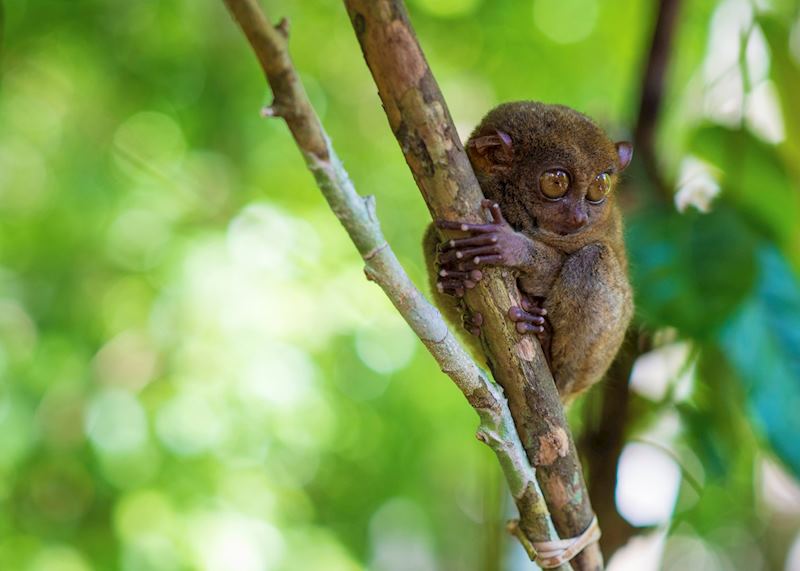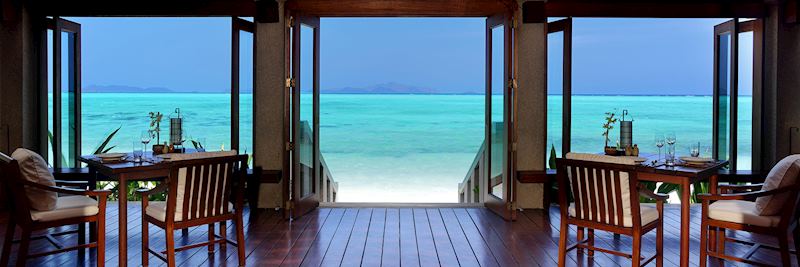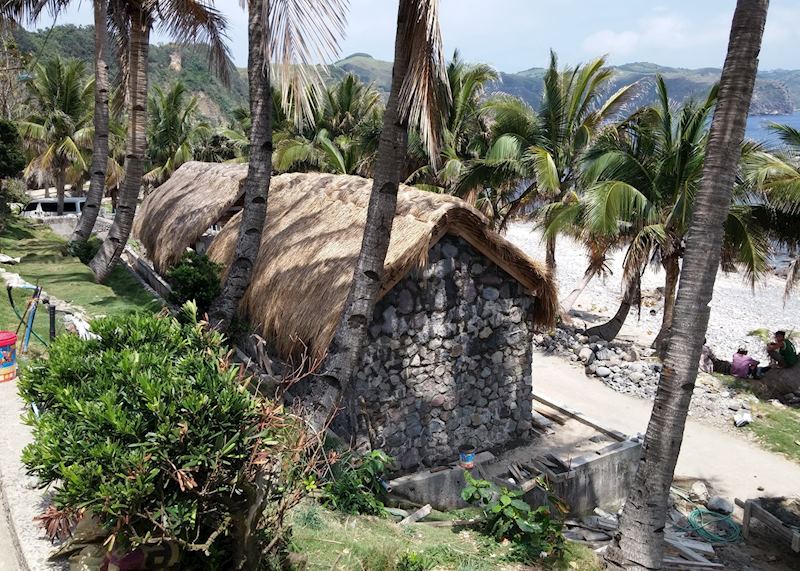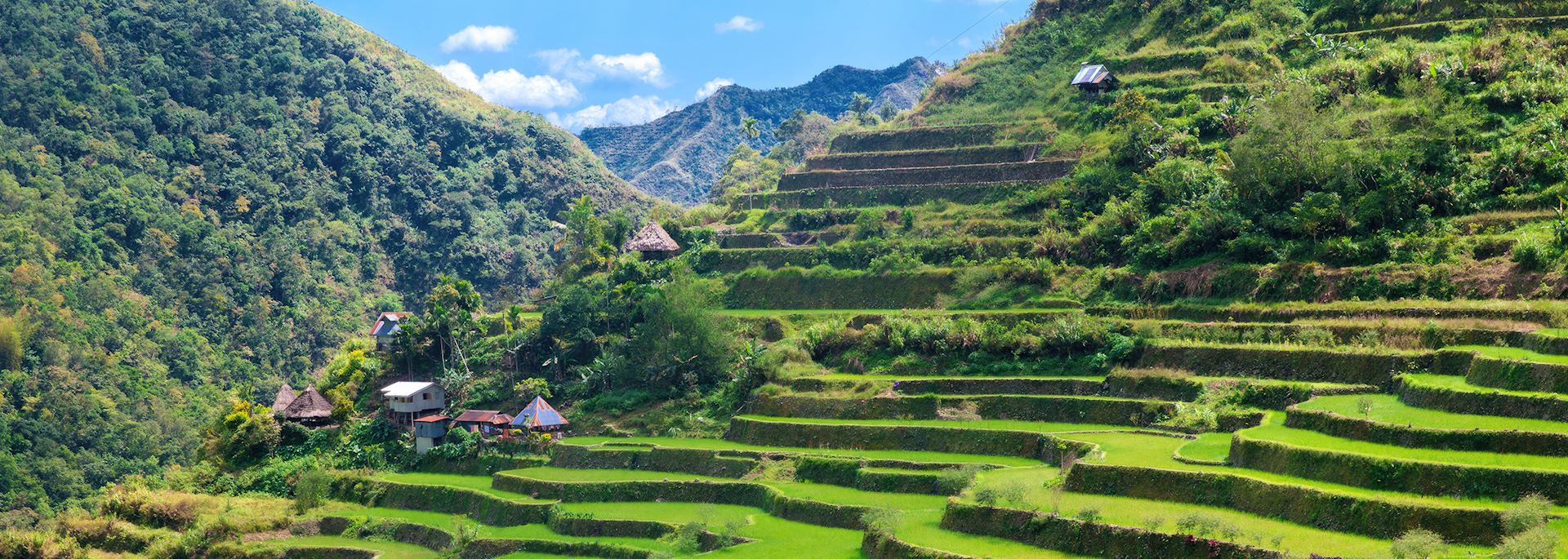By Philippines specialist David
If you've spent time in other corners of Southeast Asia, the Philippines has a surprisingly different atmosphere, akin to that of Latin America. The archipelago is made up of some 7,000 islands and proudly combines active volcanoes with luxury beach resorts, soaring rice terraces with dynamic cities, and thundering waterfalls with remote jungles.
Unsurprisingly, the country has some of the best diving and snorkeling in Southeast Asia thanks to its miles of beautiful coastline. It forms part of the Coral Triangle, which is home to 75% of the world's coral species and six out of the seven species of marine turtle.
The walled city of Intramuros in the capital, Manila, and lively fiestas, which take place during Christmas and Easter, are vivid reminders of the country's colonial past. Catholicism is still the main religion here and there are a number of churches to discover dotted throughout the country, such as St Paul Cathedral in Vigan.
Explore Manila’s historic walled city

The gateway to the Philippines, Manila is worth a few days' exploration. The city is split into 16 mini cities, my favorite of which is Manila City. This is the historic part of Manila where you can meander along cobbled streets, stopping at San Augustin, the oldest stone church in the country, Fort Santiago, and the prison cell once occupied by national hero and revolutionary Jose Rizal. Horse-drawn carts and policemen wearing colonial-style uniforms add to the district’s atmosphere.
Manila is a hectic city and I wouldn't recommend too many long journeys across it by road due to the bad traffic, but it’s fun jumping into the back of a kitsch, crowded Jeepney vehicle. These long wheelbase US army jeeps are used as public transport and each is painted in bright colors.
If you’ve a spare day, I would recommend taking the fast ferry to Corregidor Island in Subic Bay. This was the last line of defense for US forces holding out against the 1941 Japanese invasion. Highlights include the Malinta Tunnel (a bomb-proof underground area used as a bunker and later a hospital), General McArthur’s headquarters, and a Spanish lighthouse with remarkable views over Manila Bay.
Gaze over the rice terraces of Luzon

The UNESCO World Heritage protected rice terraces of Banaue, have been created and maintained using traditional farming techniques for over 2,000 years. As there is no airport, the best way to get here is by flying to Cauayan in the state of Isabella and driving the last three hours by car.
When I arrived I immediately felt a world away from the frenetic city streets. Accommodation is a little rough around the edges, though I found the rice terrace scenery and tribal culture more than made up for this.
One morning I rose early to watch the sun rise over the terraces, the morning light reflecting off the standing water. The terraces cast striking shadows at this time of the day and the mist hung over the rice plants, giving an almost eerie feel.
The real highlight was a visit to the village of Bangaan, which sits at the bottom of a small valley. You reach it by walking along the terraces, maneuvering down from one level to another. The villagers took great pleasure in dressing me up in a traditional tribal hunting outfit, which included the traditional Ifugao headpiece, a red woven blanket and a spear and shield.
I'd recommend a spot of trekking in Luzon, too. The villages of Hapao and Batad are a couple of hours' walk along the terraces, while in Sagada, you can see the somewhat morbid but fascinating hanging coffins, which suspend precariously from the cliffs and caves. Pre-dating Spanish colonization, this tradition is slowly dying out.
Delve under water in Palawan

A remote, natural frontier of rugged limestone karsts and pristine beaches similar to the Krabi Province in Thailand, Palawan is a group of islands in the western Philippines renowned for exceptional diving. Palawan is part of the protected Coral Triangle, home to over 2,000 species of coral fish. The area is also particularly good for birding.
The protected area of El Nido, in the northern reaches of Palawan, is one of the places I particularly love. It's a peaceful and remote region, with private island hotels, overwater bungalows, and exceptional diving. There is a strong local commitment to ecotourism here, with resorts growing their own organic produce and working together to protect their precious natural environment.
Trek around Taal Volcano

Drive south from Manila through sugar plantations and quaint villages and, after a couple of hours, you will reach the South Luzon region. Here, the relatively small but very active Taal Volcano rises up from the middle of Lake Taal.
There's excellent trekking in the area, particularly along the lake's edge, and also to the heritage town of Taal, which has a fine collection of 19th century Spanish and American architecture. The Galleria Taal, the town's camera museum, is quite frankly fascinating, displaying photography equipment and images that all have stories associated with them.
I would recommend spending a night in the area in order to explore further, although if you're short on time you can visit the volcano on a day trip that starts by making your way across the lake's black lava shores for a boat trip on the lake and to climb the volcano itself.
Relax on Boracay

Boracay is one of the more well-known islands in the Philippines. It's a preferred spot for weekend visitors from Manila, and the crowds that head to White Beach (a 4 km, 2.5 miles, stretch of white sand voted the world's best beach on numerous occasions) are well catered for with a large selection of hotels, bars and restaurants.
Despite its reputation as a party island, there are areas in the north that offer a more tranquil ambiance so you can experience the beautiful beaches of Boracay without being in the middle of the party scene.
Enjoy a touch of luxury on Cebu

The island of Cebu is located right in the heart of the Philippines Archipelago, within the Visayas group of islands, and contains the country's second city with a strong Spanish and Chinese heritage.
It's just a short flight from Manila to Cebu, after which you can explore the other islands in the Visayas group by boat or car — both pleasant and relaxed ways to travel, which ensure you aren't spending too much time in airport terminals. The main island is connected by road bridge to the delightful Mactan Island, a landmass made entirely of coral and home to a small selection of luxury resorts.
The Shangri-La on Mactan is always top of my list of places to stay, and I would recommend combining a couple of nights here with a stay on one of the smaller islands, like Bohol, which lies just to the south of Cebu, where intimate boutique properties are the order of the day.
Spot tarsiers in the Chocolate Hills of Bohol

.jpg?q=79&w=800&h=571)
The main draw of Bohol is the so-called Chocolate Hills. It's one of the strangest landscapes that I've ever seen; over 1,000 hills rise up from the earth like chocolate drops as far as the eye can see. There's a viewing platform on one of the larger hills from where you can take in 360 degree views of perfect, half-spherical, chocolate-colored mounds.
There are a number of old Spanish churches on the island that make interesting trekking destinations, even though an earthquake a couple of years ago damaged some.
The island is also home to the endangered tarsier, recognizable for its huge eyes and its prodigious jumping ability. I would recommend viewing these cute creatures — one of the smallest primates in the world — at the island's tarsier sanctuary. Here you can see them in a protective environment as well as trying to spot them in the wild.
The mysterious island of Siquijor

Just south of Cebu and Bohol is the mysterious Siquijor Island. Often overlooked by visitors to the Philippines, the hotel infrastructure isn't as developed as on some of the more popular islands, but I think this is part of the appeal.
It's uncrowded and has an intriguing history of witchcraft and sorcery, which you can learn about on an island tour. Though the usage of these potions and spells died out some time ago, the opportunity to discover these shadowy traditions, coupled with secluded beaches and the aquamarine Cambugahay Falls (an invigorating swimming spot), warrants a few days here.
Dropping anchor at the resort of Amanpulo

If you are looking for a bit of luxury, occupying the small island of Pamalican, Amanpulo is part of the Aman portfolio and is one of country's most exclusive and private resorts. Its 40 casitas (little houses), gourmet restaurant and open-air massage pavilion attract the world's rich and famous.
Some of the casitas sit on a stretch of white sandy beach, while others perch on stilts under the jungle canopy, but all are well spaced, secluded and private, providing you with your own sanctuary on one of the most remote tropical islands in the Philippines.
The island is surrounded by a 7 km (4.4 miles) exclusion zone where no fishing is permitted to ensure the health of the marine life. Turtles swim just a few meters off the beach and resident batfish ensure that this is another of the Philippines diving hotspots.
Located in the middle of the Sulu Sea between Palawan and Panay islands, Pamalican Island has its own airstrip, with small aircraft flights taking an hour to or from Manila.
Visit Batanes Islands


Located off the northern coast of Luzon and almost as close to Taiwan as they are to the Philippines, the Batanes are a group of islands far removed from normal Filipino life.
Here you will find rolling green hills, lighthouse outposts, jungle covered mountains, and rugged coastlines. The islands are home to the Ivatan people who still live by their traditions, including the wearing of a Vakul, a headdress made of grass fiber for sun and rain protection. You can also see houses built in the traditional way, using rock and shells with native grass roofs, with some early examples still in existence on Batan and Sabtang.
The islands of Batan and Sabtang are the main places to explore with Sabtang being especially interesting as it is less developed and more traditional. Both islands offer the perfect place to relax, but if you are keen to explore further there are a number of charming fishing villages to discover as well as trekking opportunities.
Accommodation is fairly limited on the islands but the Fundacion Pacita Batanes Nature Lodge on Batan is quite an interesting property. It was the planned home of famed local artist Pacita Abad and sits in a stunning location perched on the hills above the Pacific Ocean. Sadly Pacita never got to stay here but some of her work is still on display in the hotel's gallery.
Start planning your trip to the Philippines
Start thinking about your experience. These itineraries are simply suggestions for how you could enjoy some of the same experiences as our specialists. They're just for inspiration, because your trip will be created around your particular tastes.
View All Tours in The Philippines




